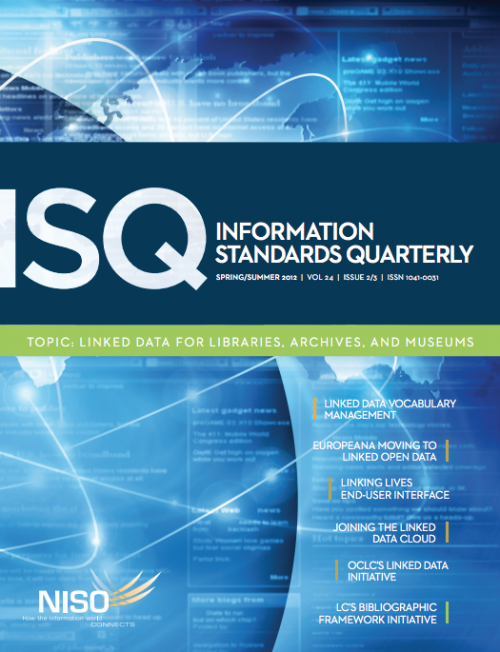Letter from the Editor
I’m incredibly excited about this issue of ISQ, focused on the current state of the linked data movement within the cultural heritage sector. In 2006, when the World Wide Web consortium re-framed some of the Semantic Web concepts under the label “Linked open Data,” the underlying concepts began to gain significantly more traction—a trend which the library community rapidly became involved in. Initial forays into linked library data focused on publishing authority data using an emerging standard called SKOS (Simple Knowledge Organization System), though in recent years we’ve seen increased publication of linked bibliographic data alongside those authorities, and the scope of publication efforts has grown beyond the borders of libraries.
Development and change in this area has been rapidly increasing, and this issue has more of an In Practice project report focus than is usually the case. This is particularly exciting, as it gives a broad overview on the scope and breadth of developments happening in the world of LOD-LAM, or Linked Open Data for Libraries, Archives, and Museums.
Jon Voss provides an opinion piece describing the LOD-LAM movement, its origins, and next steps toward planning for a global Web of interoperable cultural heritage information. From his description of the state of affairs, it’s increasingly clear that LOD-LAM is gaining prominence in the archives and museum communities as well as in libraries.
Two of the In Practice articles come from European authors, further underscoring the international flavor of LOD-LAM. First, Jane Stevenson provides a project report on the Linking Lives project, a follow on from the Jisc-funded Linked Open COPAC and Archives Hub project, or LOCAH. LOCAH was an initiative to publish extensive linked datasets derived from archival data, primarily finding aids, from all over the UK. Linking Lives, in turn, is one of the first LAM-based initiatives to design an end-user interface to a large collection of linked data in the library and archives domain. The article summarizes the progress, identifies limitations and challenges, and maps a path forward for the effective display and interface design for Linked Archival Data.
Later in the issue is a summary of the Europeana Project by project participants Antoine isaac, robina Clayphan, and Bernhard Haslhofer. Europeana is an ambitious EU-funded project to improve access to European cultural heritage materials on the Web. Like Linking Lives, it is not explicitly a Linked Library Data project, but rather a massive effort to harmonize data from libraries, archives, and museums throughout Europe into a common structure and data model. The linked data components of Europeana feed into other aspects of the project, and this article is an excellent overview of the initiative as well as a roadmap for the next steps Europeana will undertake.
Continuing in the vein of cultural heritage metadata, there is a conference report from Thomas Elliott, Sebastian Heath, and John Muccigrosso on the Linked Ancient World Data Institute (LAWDI), a three-day workshop held in May-June 2012 bringing together 50-plus researchers and digital library developers from the fields of classics, museum studies, archeology, and numismatics. This gathering was one of the first groups of academics who are not information professionals running an intensive workshop into the impact that linked data technology can have—and is already having—on their disciplines.
As the Linked Data Web continues to expand, significant challenges remain around integrating such diverse data sources. As the variance of the data becomes increasingly clear, there is an emerging need for an infrastructure to manage the diverse vocabularies used throughout the Web-wide network of distributed metadata. The feature article, by Gordon Dunsire, Diane Hillmann, Jon Phipps, and myself, discusses these infrastructure needs and describes a number of initiatives and techniques for managing diverse, heterogeneous metadata sets.
Joining the Linked Data Cloud in a Cost-Effective Manner, by Seth van Hooland, Ruben Verborgh, and Rik Van de Walle, is less a project report than a practicum. The article introduces the idea of Interactive Data Transformation (IDT) tools, such as Google Refine, that provide desktop access to the linking, reconciliation, remediation, and metadata management functionality that is one of Linked Data’s core strengths. Building on a case study using data from the Cooper-Hewitt National Design Museum, the article explains in detail how metadata practitioners looking to develop practical experience in LOD-LAM can begin using these IDTs to make iterative improvements to legacy metadata and begin linking it up with the myriad other data sources beginning to emerge in the cultural heritage sector.
The most library-focused articles come from two of the bigger library organizations in North America: OCLC and the Library of Congress. Ted Fons, Jeff Penka, and Richard Wallis provide an overview of OCLC’s initial forays into linked data technology, including a discussion of the Virtual International Authority File and of preliminary efforts to put schema.org- based RDFa (Resource Description Framework in attributes) data into WorldCat.org pages for the millions of books and other resources in WorldCat. Kevin Ford of the Library of Congress presents an overview of LC’s Bibliographic Framework Transition Initiative. The initiative, announced in October of 2011, is the initial phase in an effort to evolve and eventually replace the MARC format with a framework that better prepares library data for inclusion in the Semantic Web. The article describes how initial modeling and the development of prototype specifications and tools are building on Linked Data principles to provide a set of metadata specifications that will enable descriptions of library resources to be more effectively integrated into the Web.
I truly hope that you enjoy these articles as much as I did, and that you come away from this issue with a more practical sense of what Linked Data can do for you, your institutions, and your resources as well as some ideas about how you can begin to implement in this space. This issue will be a success if it inspires additional projects like those discussed and helps practitioners have a better sense of what steps to take to join the LOD-LAM movement.
